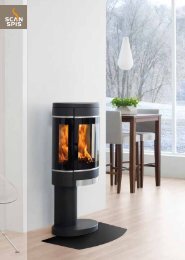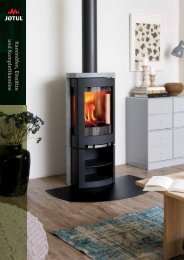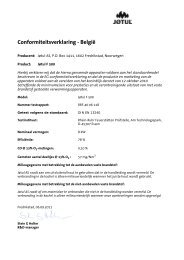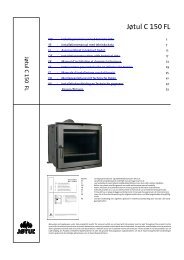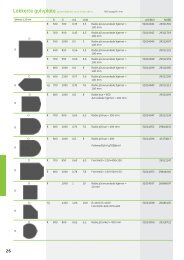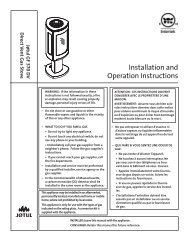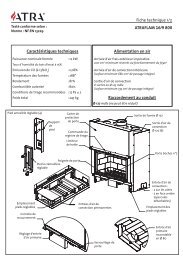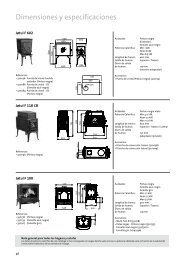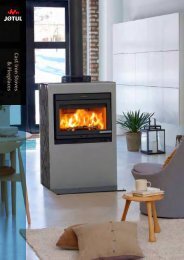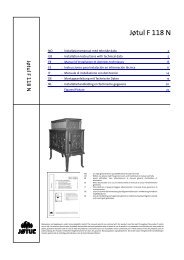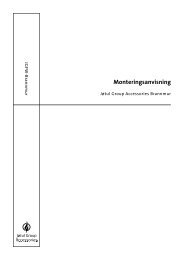Chapter 7, part 1 - Jøtul stoves and fireplaces
Chapter 7, part 1 - Jøtul stoves and fireplaces
Chapter 7, part 1 - Jøtul stoves and fireplaces
You also want an ePaper? Increase the reach of your titles
YUMPU automatically turns print PDFs into web optimized ePapers that Google loves.
tion with the workshop association in conjunction with the reorganisation. The employee representatives<br />
were included in the work of planning the zero-base budget. Furthermore, there was great<br />
underst<strong>and</strong>ing for the measures that had to be taken. The company was in crisis, <strong>and</strong> most realised<br />
that a rigorous reorganisation was crucial for further operation. Great emphasis was placed on keeping<br />
employees informed during the process. All of those who had to go were invited to meet with<br />
representatives of management, <strong>and</strong> many of those laid off were gradually rehired as production<br />
began to increase.<br />
A crossroads<br />
As we have seen, the board <strong>and</strong> administration in the first years were strongly cost-oriented.This was<br />
natural, since the primary concern was to bring the company out of the crisis. In <strong>part</strong>icular, efforts<br />
were focused on reducing the fixed costs. In this manner the company would be less vulnerable to<br />
changes in turnover. In this area the company was largely successful. Along with the group contributions<br />
from Aker the restructuring caused Jøtul by 1991 to have a profit before taxes of 18 million<br />
kroner – or 10 million more than the board had set as a goal in the budget. In the following years as<br />
well, operations showed a profit. At the same time the equity capital was rapidly rebuilt. In 1990 the<br />
board had set a goal to build an equity capital share of approximately 30 per cent over the first four<br />
years. But by 1992 the equity capital share was already 42 per cent.<br />
Financially the reconstruction proceeded quite rapidly, <strong>and</strong> by the mid-1990s Jøtul had become a<br />
rather solid company. The reconstruction was primarily based on cost cutbacks achieved by reducing<br />
investments in most areas. However, there were limits to the amount that investments could be<br />
streamlined within fundamental strategic areas such as product development <strong>and</strong> marketing<br />
efforts. The requirements for product development in the stove <strong>and</strong> fireplace market in the early<br />
1990s were presumably even tougher than before. Moreover, the competition was fiercer, making<br />
great dem<strong>and</strong>s on marketing efforts to hold on to market share. Finally, one goal was to be able to<br />
better utilise production capacity. However, this was not possible without increased exports. So Jøtul<br />
again had to start taking a more active interest in the export market.<br />
The requirements in these areas directly contradicted the requirements for minimising costs <strong>and</strong><br />
investments, <strong>and</strong> it was very important in the early 1990s to weigh these opposing needs against<br />
each other. But there was not always agreement on where the cutoff point should be. The major difference<br />
of opinion in this matter existed between the board <strong>and</strong> the administration. The board was<br />
primarily interested in keeping costs down. The administration wanted to pay more attention to<br />
rebuilding the company through a revitalisation of the product development <strong>and</strong> marketing efforts.<br />
The differences between the board <strong>and</strong> the administration in these matters were primarily related<br />
to differing ambitions. For the administration it was naturally important to build up the company’s<br />
foundation. This would primarily have to be done through an active marketing strategy, product<br />
development <strong>and</strong> the like. The owner, the Aker group, had other objectives. Aker had no industrial<br />
ambitions for Jøtul. The company did not figure in the group’s strategy for the future, <strong>and</strong> the goal<br />
was to sell it. For Aker it was therefore more important to build up solid finances as quickly as possible<br />
<strong>and</strong> not to invest in rebuilding measures that would first produce results in the long term.<br />
Reconstruction <strong>and</strong> New Expansion 209



